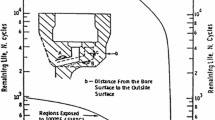Abstract
A model is proposed to quantify the accumulation of wedge type creep damage in low cycle fatigue. It is proposed that such damage is produced primarily during the ramp periods of the cycle. Equations are developed for estimating incremental accumulation of damage per cycle in fully reversed, multiaxial loading. The rate of accumulation of damage depends on the strain-rate, the temperature, and the microstructure. The analysis is kept simple by making physically reasonable assumptions. Cycles to failure are predicted by invoking a fracture criterion. The model is applied to two sets of data; one set is a well characterized life test data on an aluminum alloy, and the other is phenomenological data on austenitic stainless steels. In both cases the predictions are good enough to prompt further experimental evaluation of the model. This paper deals with only one mechanism of creep-fatigue interaction. Other mechanisms of failure,e.g., ‘r’ type cavitation, or fatigue crack initiation and propagation, are also viable. The model described here may be expected to apply only under those conditions when wedge damage is the dominant failure mechanism.
Similar content being viewed by others
References
L. F. Coffin, Jr.:ASTM STP 520, 1973, pp. 123–36.
S. S. Manson:ibid., pp. 744–82.
B. Tomkins and J. Wareing:Metal Sci. J., 1977, vol. 11, p. 414.
B. K. Min and R. Raj:Acta Metall., 1978, vol. 26, pp. 1007–22.
G. J. Lloyd and J. Wareing:J. Eng. Mater. Tech., Trans. ASME, 1979, vol. 101, pp. 275–83.
D. J. Michel and H. H. Smith:Acta Metall., 1980, vol. 28, pp. 999–1007.
S. Baik and R. Raj:Metall. Trans. A, 1982, vol. 13A, p. 1215.
D. McLean and A. Pineau:Metall. Sci., 1978, vol. 13, p. 313.
M. Kitagawa,ASTM STP 519, 1973, pp. 58–69.
F. F. Lange, B. I. Davis, and D. R. Clarke:J. Mat. Sci., 1980, vol. 15, pp. 601–10.
F. A. Crossman and M. F. Ashby:Acta Metall., 1975, vol. 23, p. 425.
C. Gandhi and R. Raj:Metall. Trans. A, 1981, vol. 12A, pp. 515–20.
S. Majumdar and P. S. Maiya:Canad. Metall. Quart., 1979, vol. 18, pp. 57–64.
“Cases of ASME Boiler and Pressure Vessel Code,” ASME Code Case 1592 (now N-47).
R. Raj and A. K. Ghosh:Metall. Trans. A, 1981, vol. 12A, pp. 1291–1302.
Z. Marciniak,Aspects of Material Formability, Dept. of Mech. Eng., McMaster University, Hamilton, Ont., Canada, 1974.
Metals Handbook, ASM, Metals Park, OH, 9th ed., 1979, vol. 2, p. 102.
S. Taira, M. Fujino, and T. Takahashi:J. Soc. Mat. Sci. Japan, 1978, vol. 27, p. 434.
B. K. Min and R. Raj:Canad. Metall. Quart., 1979, vol. 18, pp. 171–76.
Author information
Authors and Affiliations
Rights and permissions
About this article
Cite this article
Baik, S., Raj, R. Wedge type creep damage in low cycle fatigue. Metall Trans A 13, 1207–1214 (1982). https://doi.org/10.1007/BF02645503
Received:
Issue Date:
DOI: https://doi.org/10.1007/BF02645503




